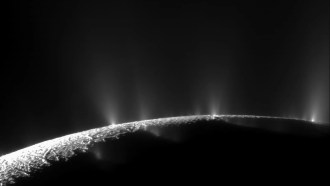Planetary Science
-
 Planetary Science
Planetary ScienceAn asteroid may have exploded over Antarctica about 2.5 million years ago
Tiny spherules of rock found in Antarctic ice may point to the oldest known “airburst,” or midair disintegration of an incoming asteroid.
-
 Planetary Science
Planetary ScienceBacteria that can make humans sick could survive on Mars
Experiments suggest that common illness-causing microbes could not only survive on the Red Planet but also might be able to thrive.
By Adam Mann -
 Planetary Science
Planetary ScienceNASA’s Ingenuity helicopter officially ends its mission on Mars
NASA’s Ingenuity helicopter suffered damage during a recent flight and has ended its mission on Mars after nearly three years on the Red Planet.
By Adam Mann -
 Planetary Science
Planetary ScienceSalt may have carved out Mercury’s terrains, including glacierlike features
Mercury may contain a planetwide cache of salt that has sculpted chaotic terrain and possibly even habitable niches.
By Shi En Kim -
 Planetary Science
Planetary ScienceA toxic gas that could help spawn life has been found on Enceladus
Cassini data indicate that hydrogen cyanide, a key building block for life, exists on Saturn’s icy moon. A snakelike NASA robot might test for sure.
By Nikk Ogasa -
 Space
SpaceIn 2023, space missions explored the moon, asteroids and more
This year, spacecraft landed on the moon, dropped off asteroid samples to Earth and started a journey to Jupiter's icy moons.
By Erin Wayman -
 Planetary Science
Planetary ScienceGiant polygon rock patterns may be buried deep below Mars’ surface
A Chinese rover used radar to reveal long-buried terrain that might hint that Mars’ equator was once much colder and wetter.
By Elise Cutts -
 Planetary Science
Planetary Science50 years ago, the first probe to visit Mercury launched
In the 1970s, NASA’s Mariner 10 became the first spacecraft to visit Mercury. Only one other probe has made the journey and another one is on its way.
-
 Planetary Science
Planetary ScienceJWST spotted a new speedy jet stream in Jupiter’s atmosphere
Seen in images from the James Webb Space Telescope, the high-altitude feature may help untangle the inner workings of the giant planet’s atmosphere.
-
 Planetary Science
Planetary ScienceMarsquakes and meteorite hits show Mars has a dense liquid metal core
Mars’ dense liquid iron core is wrapped in a layer of molten rock, which threw off previous measurements of the Red Planet’s heart.
-
 Planetary Science
Planetary ScienceGiant planet ‘destabilization’ may have coincided with the birth of Earth’s moon
New meteorite data suggest the orbits of the giant planets abruptly changed about 60 million to 100 million years after the solar system started forming.
By Bas den Hond -
 Planetary Science
Planetary ScienceHere’s another strike against Venus having copious lightning
Past data and the Parker Solar Probe’s new discovery of weird whistler waves overturn the idea that Venus’ hellish atmosphere has a lot of lightning.
By Sid Perkins